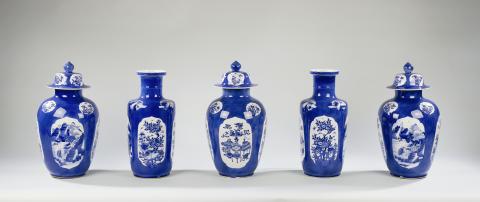The procedure
The Minister has also requested that the Committee issue a recommendation for a number of other art objects in the NK collection[1] claimed by applicants I and II. The Committee has decided to issue its recommendations on the works claimed by applicants I and II in three separate procedures, recorded under case numbers RC 1.113, RC 1.114 and RC 1.115. Applicants I and II were advised of this in letters dated 22 June 2009 and 24 August 2009.
As regards the objects that are claimed solely by applicants I, the Committee issued a recommendation on 29 June 2010 (RC 1.113). The two art objects that are part of the claims by both applicants I and applicants II (NK 688 en NK 3223 a-e) are covered in file number RC 1.114, on which this first partial recommendation RC 114-A is being issued. Due to the ongoing investigation, the Committee will issue partial recommendation RC 1.114-B regarding the claim to NK 688, and recommendation RC 1.115 concerning art objects that are solely claimed by applicants II, at a later date.
Following the requests for advice regarding Gutmann, the Committee instigated a fact-finding investigation, the results of which were laid down in a draft investigatory report dated 3 July 2008. Applicants I and II responded to this in letters dated 8 and 11 December 2008, respectively, in which both applicants I and applicants II submitted new information. On 12 December 2008, in response to the draft report, the Minister advised that he had no additional information to bring to the Committee’s attention.
As a result of the above redivision of the Gutmann files, the Committee prepared a new draft investigatory report concerning NK 688 and NK 3223 a-e (RC 1.114) on 4 August 2010.
This draft report was sent to applicants I and II for comment in letters dated 4 August 2010 and to the State Secretary for Education, Culture and Science (hereafter referred to as: the State Secretary) with a request for additional information on 5 August 2010.[2] In response to this, the State Secretary responded on 15 September 2010 that he had no additional information to bring to the Committee’s attention. Applicants I responded to the draft investigatory report in a letter with enclosures on 13 October 2010 and applicants II in a letter with enclosures on 12 November 2010.
New facts concerning NK 688 emerged after the draft investigatory report had been sent to the respective applicants and the State Secretary on 4 August 2010. These new facts prompted the Committee to pursue further investigations. In view of the fact that further investigations concerning the garniture (NK 3223 a-e) were not necessary, the Committee decided to divide file RC 1.114 into two separate partial recommendations. The current partial recommendation RC 1.114-A concerns NK 3223 a-e; partial recommendation RC 1.114-B concerns NK 688.
The draft investigatory report has been amended on certain points in response to the reactions from applicants I and II. The investigatory report for case RC 1.114-A was subsequently adopted on 6 December 2010. For the facts on which this case is based, the Committee refers to this report.
Applicants II were represented in this procedure by lawyer O. Ossmann of Winterthur (Switzerland).
[1] The Minister’s request for advice dated 18 April 2007 regarding the claim submitted by applicants I concerned the objects NK 596, NK 605, NK 688, NK 1960, NK 3147 A-B, NK 3214, NK 3215, NK 3216, NK 3217 and NK 3223 a-e. The Restitutions Committee initially recorded this application for restitution under file number RC 1.74. The Minister’s request for advice dated 16 August 2007 regarding the claim made by applicants II initially concerned the abovementioned NK works, except for NK 688. This application for restitution was initially recorded by the Restitutions Committee under file number RC 1.94. On 22 April 2009, applicants II advised that they no longer requested restitution of the objects NK 605, NK 1960, NK 3147 A-B, NK 3214, NK 3215, NK 3216 and NK 3217. This was followed on 15 June 2009 by a request for advice from the Minister regarding the claim made by applicants II for NK 688, NK 2758, NK 2947, NK 2965, NK 2966 and NK 2967. These developments prompted the committee to divide the Gutmann files again, as stated in the current recommendation.
[2] The State Secretary for Education, Culture and Science took over this restitution file from the Minister on 24 February 2010.
